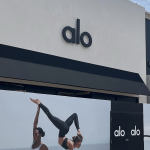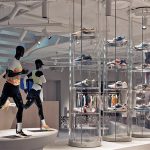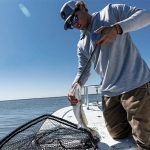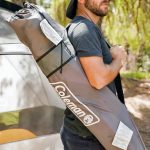This years Super Show Financial Day revealed few surprises. Most presenters stuck to their prepared scripts. Attendance seemed lower than last year, as other financial conferences intrude on the timing. SEW brings you the high points of the conference.
John Horan, moderator of the Super Show financial Day, opened the conference by citing several data points about the year just completed.
Some highlights of the presentation:
- The highly promotional environment continued in big box sporting goods.
- Profits improved for the industry, especially in H2
- Market growth remains modest.
- Total retail square footage expected to grow by +10% in 2004.
Over the last two years, retail square footage growth, by segment:
- Big Box Outdoor, +41%
- Golf Specialty, +42% (although there was not a lot of ownership for this point)
- Mall Athletic specialty, +2%
- Full Line Big Box, +18%
- Full Line Small Box, +18% (mostly driven by HIBB)
CEO Doug Morton noted in his presentation for The Sports Authority that the integration of the old TSA and Gart was ahead of plan and “light years ahead of previous integrations”.
Highlights of the integration included a reduction in field staff; adding operational controls at old TSA designed to reduce shrink by 70 BPS; closed 8 old TSA and 1 old GRTS store, described as “overlapped and underperforming”; eliminated 60% of Gart corporate office and relocated 121 people from FL to CO.
Morton felt that the just completed Holiday season was “no more promotional than Last year.”
CFO Tom Hendrickson described the previously described “merger of equals” as “just a purchase.” Expected synergies are: enhanced sales and margins, expansion of “premium brand” products; Expansion of Private Label to 11% of total; leveraging of GRTS winter sports expertise, and a reduction and reinvestment in redundant marketing dollars.
Hendrickson noted that, in order to reach earnings targets, TSA “must grow 5% in square footage over the next three years.
Morton indicated that the footwear presentation would change in remodeled stores to a “hybrid model”, with shoes over $75 sold in full service format and shoes under $75 sold in self service. Said he saw no “increase in sales or penetration” in old TSA stores which had been converted to full service footwear.
Morton declined to comment on the results of the recent remodels, as they “are still working on them”
Dicks Sporting Goods CEO Ed Stack in explaining the industry leading results described the key initiatives DKS had embarked upon several years ago: Improve turns, make invest capital more productive, increase margin and increase comps.
Stack said the bid for the acquisition of Bobs Stores was “a real estate play”, designed to speed up their expansion into New England.
Stack felt the promotional environment at Holiday “was no different than LY”. He also noted that the rapid expansion of the Big Box Outdoor specialty chains “wont impact their strategy. “We have not found it to have had a meaningful impact on the business,” he said.
SEW has heard the straightforward — and always entertaining — Hibbett Sports presentation so many times we should be able to give it by now. Mr. Newsome always draws a crowd, and not just for the trivia questions. Some bon mots from Governor Newsome:
“We build brands; we dont tear them down”
“Real Estate is the most important part of the free enterprise system.”
“Its not our goal to beat anyone on price.”
“Wal-Mart is our friend, not our enemy.”
“We build stores where we are needed; needed by the vendors, the customers, the landlords and the community.”
Three key initiatives were outlined by Foot Locker, Inc. Chairman Matt Serra:
“Grow the base in Europe, expand the direct to consume business and “cultivate the base business”.
Serra detailed the final point as meaning to” open new stores remodel or relocate selected stores, reduce build out costs and down size or close underperformers. Serra said he expects occupancy to decline by 50 bps in 2004.
Asked about the strength of the Holiday season, Serra cited retro and classic styles, Boots (especially Timberland) and the new exclusive 20 pack program from Nike. He said the brown sneaker trend accounted for 10% of sales for Holiday. Apparel was described as “fairly strong, but not as fantastic as it had been.”
Asked about the Nike relationship, Serra said they were still “working on getting Jordan Retro” and that they would have the LeBron James shoe in June, although the number of doors was not specified.
Serra said the chain “promoted less in fourth quarter this year,” citing owning “the right merchandise” Looking forward, he predicted that the classic whiter shoe category “would not experience a slow down for at least another year.”
The Finish Lines founder and CEO, Alan Cohen, as reticent s ever, revealed that they chain is experimenting with both Lifestyle Centers and Street Locations. Should these tests turn out positive, The Finish Line “could go well beyond 800 doors.”
Many of the questions were about the apparel business that has driven the comps at FINL all year. Some highlights from Cohens answers:
“Licensed is going to continue to be strong.”
“Branded apparel is going to start up again.”
“2004 will be a big year for Blue Label (private label brand).”
“Licensed was 60% of sales in 2003. That may drop a little. We are going to be more cautious. We think it will be a more fan-based business.”
Asked about plans for the current cash level, Cohen concluded, “We have the balance sheet to do what we want to do.”















